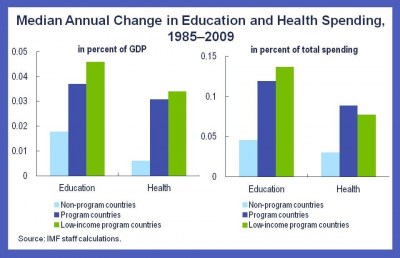All too often we hear the claim that the programs the IMF supports in low-income countries hurt the most vulnerable by forcing cuts in social spending. This is a misconception.
Our study concludes that, contrary to these claims, IMF-supported programs boost education and health spending in low-income countries for as long as countries are engaged with the IMF.
Let the numbers do the talking
We based our analysis on public spending on education and health in 140 countries between 1985 and 2009. The dataset is the most comprehensive ever assembled to assess this issue. The results show the beneficial effects for social spending in program countries in several respects.
First, social spending increased at a faster pace in countries with programs compared to those without, particularly for low-income countries with programs (see chart). This is true for social spending in relation to GDP and as a share of total government spending, as well as increases in per capita social spending after adjusting for inflation.

Second, the benefits for social spending have accelerated over time in low-income countries.
- The median annual increase in education and health spending in low-income program countries since 2000 was more than double the average increase during 1985-1999. The rate of increase since 2000 implies that education and health spending, as a share of GDP, would increase each decade by 0.7 percentage points and 0.6 percentage points, respectively.
- Because GDP is also growing rapidly in these economies, increases in spending relative to GDP imply large increases in spending per capita. The rate of spending growth since 2000 suggests that education and health spending per person, after adjusting for inflation, would rise by about 50 percent and 60 percent, respectively, over a 10-year period.
Of course, IMF-supported programs are not the only determinants of a country's social spending. Many other factors--age profile of the population, income levels, and macroeconomic conditions--come into play. A fair test of the impact of IMF-supported programs on this spending must take these factors into account.
Using statistical techniques that distill the impact of an IMF-supported program, as distinct from these other factors, we again find that IMF-supported programs have a positive, and even stronger, effect on the rate of increase in social spending in low-income countries. For example, over a five-year period with IMF-supported programs, education spending increases in low-income countries by about ¾ percentage point of GDP; and by about 1 percentage point of GDP for health spending.
Facilitating social spending
The IMF is committed to help protect or increase social spending in the programs it supports in low-income countries. In this regard, there are numerous channels through which programs help spur higher spending in education and health, including:
- Reforms that increase government revenues--on average, program countries increase revenues at a brisker pace than non-program countries--help create "fiscal space."
- IMF-supported programs help countries mobilize donor financing.
- To the extent that programs lead to higher growth, they can help generate greater fiscal space.
- Finally, the emphasis in these programs on using additional resources--including those generated by debt relief--to support poverty-reducing spending contributes to rising shares of education and health spending.
The results suggest that IMF-supported programs are compatible with the efforts of countries to boost critical social spending to improve social outcomes. But, it will be equally important, as many scholars have emphasized, to improve the targeting and efficiency of public spending to make it a more powerful instrument for bettering the lives of the poor.
From iMFdirect blog
